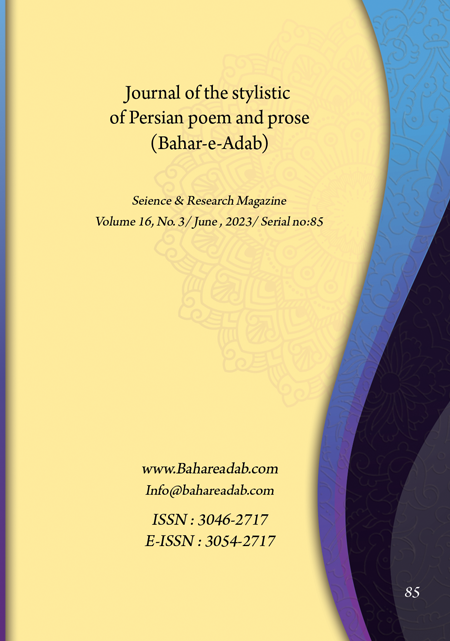- Count View : 305
- آدرس کوتاه شده مقاله: https://bahareadab.com/article_id/1456
- کد doi مقاله: Doi: 10.22034/bahareadab.2023 .16 .6849
Journal of the stylistic of Persian poem and prose
volume Number 16،
number In Volume 3،
،
issue Number 85
Analyzing the style of the popular footnote novel from 1320s to 1332s, with a look at Tehran Makhuf by Mushfeq Kazemi and Ten People of Qezelbash by Hossein Masrour
Akram Asgari , Fatemeh Pakrow (Author in Charge), Hamidreza Ardestani Rostami
Abstract
BACKGROUND AND OBJECTIVES: Footnote novel is a new phenomenon and a branch of literature. This contemporary literary trend has attracted people"s attention and is rooted in popular literature and is a reflection of the current issues of society and reflects political, social and historical events like a mirror. As a social novel, along with the growth and richness of the literary stream, it shows the weaknesses and cultural defects of the society with simple language and general structure. At the same time as the political and social disturbances at the end of the Qajar period, writers with a sharp pen showed the idiosyncrasies of the society. First, the social footnote novel Tehran Makhuf by Mushfeq Kazemi with the theme of love and simple prose and report-like language, and then the historical novel Ten People of Ghezelbash by Masrour were written with the aim of encouraging patriotism. The purpose of this essay is to analyze the style of these two works.
METHODOLOGY: This essay has investigated the narrative style and intellectual content and special style of these two novels with a descriptive-analytical method.
FINDINGS: Popular novels because of having certain stereotypes and frameworks throughout the work, from the title to the ending, events, characters, story line and fixed theme such as love triangles and squares, falling in love between a boy and a girl from two different social classes, and plot The cover can be separated from elitist literature. All these characteristics are mainly based around a simple axis and to make the story interesting.
CONCLUSION: The language in these two novels, according to the type of audience, is simple, far from complexity and difficulty. In both novels, love and homeland are two main characters. In fact, earthly love and love for the homeland are parallel to each other. Another feature of these two works is their symbolic language and irony. There are many characters in them and each one represents a certain class of society. In Tehran makhuf, we are witnessing serious criticism of women"s issues, and the author"s approach is more social; But in the Ten people of Ghezelbash, the main approach is historical and patriotism and religiousism are more prominent.
Keyword
stylistics
, popular footnote novel
, 1320s to 1332s
, Tehran makhuf
, Ten people of Ghezelbash
- Abaiy, Christoph. (1996). The Genesis of the Persian Novel, translated by Mahvash Ghadimi and Nasrindokht Khatat, Tehran: Moein and the French Iranian Society.
- Azhand, Ya’qoub. (1995). "Types of novels (1)", fiction literature, Shahrivar, (35) 3, pp. 15-19.
- Dobwar, Simon. (2008). Second edition, translated by Qasem Safavi, Tehran: Toos.
- Khosravi, Abu Torab. (2012). Roud Ravi, 4th edition, Tehran: Cheshme.
- Lis, Tysen. (2014). Theories of Contemporary Literary Criticism, translated by Maziar Hosseinzadeh, Tehran: Hakayat Qalam Novin.
- Masrour, Hossein. (2000). Dah nafar Ghazlbash, Tehran: Dabir.
- MirAbdini, Hassan. (2001). One Hundred Years of Story Writing in Iran, Tehran: Cheshme.
- MirAbdini, Hassan. (2011). Fiction literature, Tehran: Cheshme.
- Mirsadeghi, Jamal. (2019). Fiction, Tehran: Bahman.
- Morrison, George and Others. (2001). Iranian literature from the beginning to today, translated by Ya’qub Azhand, Tehran: Gostareh.
- Moskub, Shahrokh. (1994). Haghigi Novel, Tehran: Forozan Roz Research.
- Mushfeq Kazemi, Morteza. (2011). Tehran Makhuf, Tehran: Omid Farda.
- Safa, Zabihullah. (2004). Epic writing in Iran, 7th edition, Tehran: Amirkabir.
- Safa’ei, Ali and Mozaffari, Kobra. (2008). "Descriptive, analytical and critical review of Iranian popular novels", Adab Pazhuhi Magazine, No. 10, pp. 109-136.
- Sepanlo, Mohammad Ali. (1995). Parables, by Baqer Mo’meni, Tehran: Andisheh.

